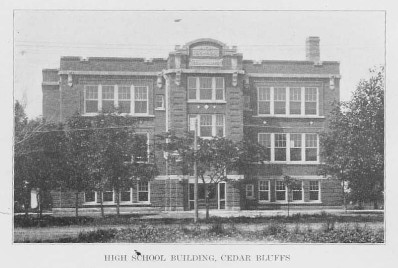
High School Building, Cedar Bluffs
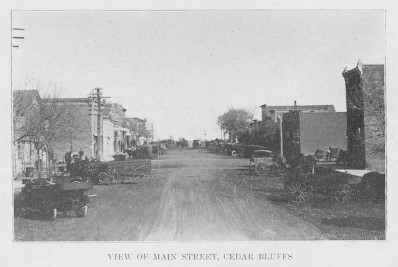
View of Main Street, Cedar Bluffs
CHAPTER VIII
THE CITY OF CEDAR BLUFFS
BEGINNING OF TOWN
The early settlers of the northern part of Saunders County underwent a great amount of hardship in the difficulty of reaching a market with their product. Fremont was the closest town for many years and in the early days the only way of reaching this city was by fording the Platte River and many a thrilling' experience was had in crossing this treacherous stream. Many a load of grain was lost, many a load of simple household goods was immersed, in the attempt to get across to a market. Provisions which were meant to last for a whole season were carried down stream to the best fording site and there transported over to the Saunders County side, the drivers thankful when the south side of the river was gained. Naturally, this brought the marketing of the crops to the point of peril, until a bridge was built to lessen the danger. The building of the Lincoln line of the Chicago and Northwestern Railroad in 1886 lessened the burden of marketing, for with the building of the road the Town of Cedar Bluff's came into existence and with it the country surrounding began to develop and enlarge until it has reached the generous proportions which it now enjoys. Where this city is now located was once the site of a corn field, the property of M. Fouquet and W. R. Sampson, and the town site company cleared a portion of it for the original lot sale. This was a. big event for many of the people in the community. The town site people bought from Fouquet and Sampson for $40 per acre; a price which seems ridiculous in the light of the present value of town property in Cedar Bluffs. After the town had become a fact R. H. Knapp, who has been prominent in the community, passed judgment that, while he never see the day, the younger men of the town would see
113
114 PAST AND PRESENT OF SAUNDERS COUNTY
a time when land in the neighborhood would sell for as much as $75 per acre. Mr. Knapp lived to see some of this land sold for $225 per acre.
FIRST BUSINESS HOUSES
The first store to open for business in the new town was a hardware store. Jansa and Ficenez, who came here from Wahoo, put up a building on the corner where the Lockner hardware store is now located. It was a frame structure. Killian Brothers, who also had a store at Wahoo, formed a partnership with Henry Fuhrman under the firm name of Killian Brothers Company and started the first general store, the second place of business in the town. Goods were shipped from Fremont and Wahoo on a construction train soon after the steel rails of the Northwestern Railroad were laid. Mr. Killian and John Stuehrk rode on top of a box car to watch the surplus goods which had been piled there, no more room being available inside the car. Mr. Stuehrk was a clerk in the store and when John Killian retired a few years ago, he and Mr. Killian's son, L. R. succeeded to the business. Several other buildings were in the course of construction during the first months of the town's existence and among them a hotel. L. M. Dickey, who was the original landlord, conducted a boarding house under the canvas wall of a tent during the construction of the hotel and the people slept in the same place.
The Nye Colson Company of Fremont put in a lumber yard just as soon as the stock could be hauled in on construction trains, with Lewis Kreymborg and Gil Byorth in charge and soon after it was in operation Josh Brainard was employed to take charge of the office work. W. H. Ferris, one of the pioneers of Saunders County, sent for Dr. A. E. Stuart at Windsor, Canada, and after his arrival they started a drug store in partnership. Doctor Stuart had spent some time practicing medicine in Michigan and he continued his practice here. He also received the appointment as the first postmaster of Cedar Bluffs, which office he held for 2 1/2 years, resigning upon the election to the presidency of W. H. Harrison, R. J. Fleming succeeding him.
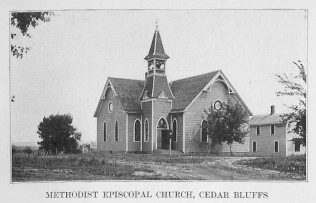
Methodist Episcopal Church, Cedar Bluffs
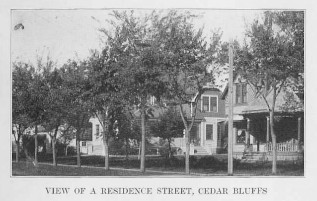
View of a Residence Street, Cedar Bluffs
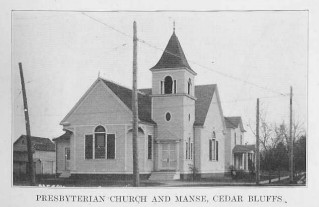
Presbyterian Church and Manse, Cedar Bluffs
PAST AND PRESENT OF SAUNDERS COUNTY 115
Thomas Hendrickson started the first saloon and had Henry Hoist for his bartender. Other Fremonters early on the scene in business were Charles Harlan with a meat market and E. H. Monroe with a hardware store. B. Baldwin started the first livery. Judge William H. Ely was also an early resident of the town.
The second general store was started by H. W. Reints, which was later purchased by L. J. Schere, who still continues the business. A. C. Thomas operated the second hotel and J. V. Moran the second drug store. But two members of the original town board are now living in Cedar Bluffs -- John Killian and Doctor Stuart.
John Carlson also ran a hotel in the town and Ed Knapp owned a meat market.
Cedar Bluffs was incorporated in 1887, when there were 200 people living in the place. The same year the ground was platted. At this time, also, the Methodist Episcopal Church building was moved into town from the Chapman farm. The old grange hall two miles east of town was brought into the corporate limits and was used as a town hall. E. H. Monroe was the first chairman of the town board, the others being Doctor Stuart, J. V. Moran, John Killian, J. B. Brainard. Henry Dierks was the first marshal.
The first celebration in the town was held in August, 1887, to celebrate the establishment of the Farmers Elevator Company. At this time the Farmers Alliance was in the limelight. Anti-monopoly speeches were made by Senator Van Wyek, ex-Governor Butler and L. J. Abbott.
The following men have served as postmaster of Cedar Bluff's: William D. Farris, Dr. A. E. Stuart, R. J. Fleming, John Young, C. A. Jackson, George Young, Whitney, Walker, Sampson, John Fenstermacher and Will Nick.
The electricity used by the town is provided by the Fremont Gas, Electric Light and Power Company, under contract made in 1913. The municipality built a line connecting with the company's system at the top of the old bridge hill on the Booze farm. The City of Cedar Bluffs also has a very satisfactory system of waterworks, comprising two air-pressure tanks of 12,000 gallons
116 PAST AND PRESENT OF SAUNDERS COUNTY
each and two gasoline engines, with pumps and wells of sufficient capacity to supply any need of the town.
BANKS
The banking business is represented in Cedar Bluff's by two strong institutions, the Bank of Cedar Bluffs and the Farmers and Merchants State Bank. The former bank was organized in the year 1887 with the following officers: R, H. Knapp, president; Peter Wolff, vice president; F. A. Gilbert, cashier. The first capital stock was $7,500, which sum has now grown to $20,000. The bank was established in a plain wooden building which stood on the site of the new brick structure. Mr. Knapp served; as president until 1913. The present officers in the Bank of Cedar Bluffs are: F. B. Knapp, president; P. Wolff, vice president; J. H. Mackprange, cashier; and R. J. Fleming, assistant cashier. The bank carries a surplus fund of about twelve thousand dollars and the deposits for the year will average very close to three hundred thousand dollars.
The Farmers and Merchants State Bank was organized in 1892. John Killian was the president; P. F. Ebson, vice president; Henry Wehner, cashier. The first capital was $10,000. The officers in 1915 are: Charles S. Williams, president; J. P. Gessen, vice president; H. C. Hatterscheiv, cashier; and F. E. Wehner, assistant cashier. The capital stock of this institution is $20,000; the surplus, $12,000; undivided profits, $5,600; and deposits averaging $225,000.
THE STANDARD
The Cedar Bluffs Standard is a live and prosperous weekly issued under the editorship of James Pickett, the son of T. J. Pickett, editor of the Wahoo Wasp. The Standard was established twenty-five years ago and has had many owners and managers since that time. The latest news of the northern part of Saunders County is featured every week and, considering the nearby competition of Fremont, the paper is first class in every particular.
|

